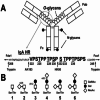Progress in Pathogenesis of Immunoglobin A Nephropathy
- PMID: 32724739
- PMCID: PMC7381842
- DOI: 10.7759/cureus.8789
Progress in Pathogenesis of Immunoglobin A Nephropathy
Abstract
The understanding of the pathogenesis of any disease is the key to effective and specific treatment of the disease. immunoglobulin A (IgA) nephropathy is an autoimmune disease of the kidney. Oxford MEST classification is commonly used to stratify patients according to the severity of the disease. Patients with IgA nephropathy seem to produce anti-GalNAc antibodies against a particularly defective IgA1. This immune complex deposits in the kidneys, leading to a type 3 hypersensitivity reaction which ultimately damages the kidneys. People of a certain genetic background and who experience upregulation of certain defective receptors seem to develop primary IgA nephropathy. Secondary IgA nephropathy could be due to dysbiosis of the microbiota in the gut, compromised gut immunity or other gut pathologies, pulmonary function abnormalities, or amyloidosis. Overproduction of IgA due to plasma cell dyscrasia or reduced clearance of IgA due to liver abnormalities could also be potential causes. Genes that predispose individuals to IgA nephropathy and intestinal abnormalities, such as Celiac disease, seem to overlap and these people tend to have a poorer prognosis and need to be placed on more intensive treatment regimens. IgA Vasculitis seems to be a systemic form of IgA nephropathy, whereby IgA deposits systemically and leads to multiple disease manifestations. Patients in high-risk groups could also be prophylactically screened for the disease and closely monitored by immunohistochemical methods such as an enzyme-linked immunosorbent assay (ELISA) or identified by genetic testing. Currently, the major treatment regimens involve supportive therapy or immunosuppressive therapy which has major side effects. More specific treatment methods such as monoclonal antibodies, immunoglobulin replacement therapy, or low-antigen-content diet could also be looked into as potential treatment options. Stem cell replacement, by way of bone marrow transplant and tonsillectomy, has been suggested as a treatment option in patients with indications.
Keywords: autoimmune; gut-kidney; iga nephropathy; iga1; treatment.
Copyright © 2020, Stanley et al.
Conflict of interest statement
The authors have declared that no competing interests exist.
Figures
References
-
- Oxford Classification of IgA nephropathy 2016: an update from the IgA Nephropathy Classification Working Group. Trimarchi H, Barratt J, Cattran DC, et al. Kidney Int. 2017;91:1014–1021. - PubMed
-
- Latent IgA deposition from donor kidney is the major risk factor for recurrent IgA nephropathy in renal transplantation. Moriyama T, Nitta K, Suzuki K, et al. https://www.ncbi.nlm.nih.gov/pubmed/15955168/ Clin Transplant. 2005;19:41–48. - PubMed
-
- Immunoglobulin A nephropathy in China: progress and challenges. Cai GY, Chen XM. Am J Nephrol. 2009;30:268–273. - PubMed
Publication types
LinkOut - more resources
Full Text Sources
Miscellaneous


